Education & Outreach
DANCING ON THE KEYBOARD
by Felice Lesser
I needed an out. If asked why there was to be no performance scheduled for the end of this year's Dalton Elementary School residency (in Coeur d'Alene, ID), I would say, The emphasis this year is on process, not project. That was the excuse. The real reason was that I had no idea how this residency was going to turn out. It was the first time I was teaching dance composition to students this young, and more importantly, it was the first time I was bringing my computer choreography and animation work into the classroom. My intention was to teach fourth graders how to choreograph dances, both in the studio and on the computer screen (using Life Forms, a computer animation program, developed by Dr. Thomas Calvert of Simon Fraser University). It all came down to whether or not children could be taught how to use this rather sophisticated software. And if they could, there was still that little matter of teaching kids with almost no dance training how to make a dance. Choreography is generally something one approaches long after one has studied dance technique for years. How much could be accomplished in ten days?
This was the second year of a two-year residency at Dalton, organized by visionary Idaho arts specialist, Jane Morgan for a core group of sixty third graders. During the first year they learned the rudiments of dance -- through a study of folk dances from different countries. The second year (with the students now in fourth grade), they would move to more formalized study, with daily technique classes -- and exercises in dance composition. Simultaneously, they would be exposed to Life Forms in the computer lab, where dance composition would be seen in another light. Dr. Calvert generously arranged for Credo Intermedium to donate the software to the school, and with a grant from the Idaho Commission for the Arts, we were on our way.
I arrived at Dalton in April, feeling as if I had never left. The boys were a few inches taller; one or two of the ten-year-old girls were prematurely experimenting with new hair colors and make up, but were more or less the same. Especially nice was the fact that for once I didn't have to go through the usual tests that students throw at a stranger in their midst. I had passed those the previous year. By this time they were used to me, and were eager to get to work. We embarked on our exploration of ballet, modern dance, jazz, and tap. Everyone was having a great time. Kids love the challenge, energy and excitement of dancing. After one particularly grueling physical workout learning a rather intricate and difficult jazz combination, they were sent out to the water fountain. As they trickled back into the gym, I noticed they were practicing -- without having been told to do so. Within minutes the gym was filled with children lost in their own worlds, concentrating intently yet fully enjoying themselves. They were laughing and yelling out loud, one-two-three-four-shift-turn-step-touch, dancing unselfconsciously. Those are the moments you remember.
Meanwhile, in the computer lab, they learned very quickly how to move the limbs of the Life Forms figures into poses, to link a number of these figures into phrases, and then animate them, much like a cartoon. Once we began looking at dance composition in the studio, correlations were made between what they were doing on the computer screen and with their own bodies. The concept of symmetry was easily understood by using the mirror command. You could pose an arm in a half circle for instance, and then using the command, make the other arm give you exactly the opposite image, completing the circle. They were learning anatomy and kinesiology without realizing it. I'd ask them how they'd make a computer figure do a step we were working on in class. They'd have to visualize it -- breaking down the components of the movement, so that they could recreate it on the screen. That also added to their understanding of how to execute the step in the first place. Then there was the fun part. Imaginations were allowed free reign. One of the best things about Life Forms is its ability to do away with the limitations of the human body. Gravity doesn't exist, a dancer can turn indefinitely, or jump through the roof. Nothing is impossible. It was interesting to watch the students try out these wild things on the computer, and then, alter them in the studio, so that their very real bodies could execute the movements. It seemed they understood (perhaps better than I) the difference between reality and fantasy.
The kids worked in groups, collaborating on their choreography. As there weren't enough computers to go around, four or five students were assigned to each, making it necessary to share and take turns. Everyone had a different colored figure, a place, a voice, an equal chance to participate in the process. For me the most rewarding moments came when a student would accidentally stumble onto a fundamental concept. It's easier to teach what unison or a canon is, or how you use a soloist with a group, when the students' studies would demonstrate just those things.
I learned a lot about dance composition in those two weeks. Kids with no preconceived notions about what a dance is, will force you to question what you thought a dance was all along. And I learned more about handling what is generally quite a struggle in this country--turning boys on to dance. I thought I had found a pretty successful way -- teaching them the fun steps (such as grand jétés and other big leaps) in ballet first, and then once they were hooked, going back and teaching them the fundamentals of executing the technique properly. But this residency presented me with an additional weapon. Computer animation. This generation is as familiar with computers as my own was with TV. What a non-threatening introduction to dance and movement this turned out to be! It was no challenge at all to have them create a dance on the computer. Once they had done that, getting them to recreate it in the dance studio was no problem, whatsoever. It was the logical next step.
In the end we did have a performance -- a demonstration of the different dance techniques we had studied in the two weeks, and then a presentation of short movement studies choreographed both in the studio, and on the computer. The kids then brought their parents into the computer lab and showed off their Life Forms assignments. The evening was a huge success. But for me the very best moment came earlier in the week, after we had finished one of the technique classes. The students had just gone outside for recess. I packed up my dance bag, and was about to leave the gym, when I looked out the door. There, standing alone near the garbage pails was a ten-year-old boy -- one of the students in my class. He glanced around furtively, and when he was certain no one else was looking, he started to move - practicing the dance combination he had just learned in class.
© 1998 Felice Lesser All Rights Reserved
______________________
TO SLEEP, PERCHANCE TO DREAM
by Felice Lesser
Most of the people in my audience were fast asleep. In my defense I must say it had nothing to do with my delivery or the subject about which I was speaking. My audience consisted, for the most part, of elderly homeless people who had been out on the frigid New York streets all night. They had found their way to my presentation on the ballet, not to hear me talk about Swan Lake, but to take a nap in a comfortable chair in a warm room.
I had arrived at the senior center a few months earlier, when I needed to film elderly people for a "video backdrop" for one of my dance works. The facility had large picture windows through which one could see rows of long school-cafeteria-style tables where people ate and socialized. What intrigued me was how the traffic’s reflection played on the windows -- so that buses and taxis moved across the faces of the people inside. The images brought to mind the feeling of life passing one by. So I asked for permission to film there in exchange for presenting a free series of lecture-demonstrations on dance. The first part of the project went very well. I shot the video, using the people there -- vibrant, energetic seniors who were eager to participate. As I filmed they’d tell me stories about their lives -- tales of riding long-gone NYC trolley cars, and they pointed out locations of buildings from their pasts, seen through the picture windows, that no longer stood.
Then the winter came, and the lecture-demonstrations began. But I never counted on the new reality that emerged. The cold had set in, and the seniors I had filmed were nowhere to be seen, as an entirely different clientele took over the large multi-purpose room -- the elderly homeless. They slept in the comfortable chairs in front of the large-screen television where my lecture-demonstrations were to be held. I certainly couldn’t -- and wouldn’t -- ask anyone to move -- especially someone who had been out on the streets all night. So I gave my lecture in front of people who simply ignored me. Actually they didn’t ignore me. Fast asleep, they didn’t even know I was there. I talked about maidens turned into swans and wicked sorcerers -- which seemed so ludicrous as I stood before those who didn’t have places to live, or food to eat. And there weren’t going to be any princes rescuing them unless our country suddenly did an about face, which wasn’t likely to happen anytime soon.
Most were in poor health, and their crutches and canes rested against their chairs as they slept. How had they come to be here? Where were their families? Is this what happens to you when you grow old, alone and poor in America? I wondered if any of them had at some earlier, better, point in their lives even seen a ballet? Or had their lives always been so centered on trying to stay alive, that they never had the luxury of feeding their spirits as well as their bodies. For basic needs must be met before one can nourish one’s soul. Who could even care about beauty in such a harsh, cruel environment?
Surviving in the bitter cold night after night, they were at least taking advantage of this one place where they could find a free meal and sleep in the warmth for a few hours. I stood there, not knowing quite how to proceed, trying to ignore the deep coughs that would occasionally wake one of them, providing a strange counterpoint to Tchaikovsky’s melodic score. I remember a man suddenly waking and seeing me there in front of him. He caught my eye and nodded repeatedly, as if he were pretending to listen to what I was saying. There was fear and humiliation in his eyes. It occurred to me that he might be afraid that if he didn’t respond appropriately someone might ask him to leave. Being turned away must have been a daily occurrence in his life.
I asked myself, “Why am I doing this? If I stop talking, I can let them sleep in peace.” But there were a few others present, who weren’t homeless, and who had ventured out in the cold for the cultural enrichment. Scanning the faces, I’d catch those sparks of recognition and enjoyment in eyes that were bright and interested. For this handful I could do what I usually did in educational events -- explore the works in depth, show the stellar videotaped performances, and bring pleasure into their day. One man nodded in agreement as I’d say something. Then he'd move in time to the music when I stepped back and let the dance speak for itself. His eyes, unlike those of the other man, didn’t contain the element of fear. There were questions -- “Which company performed this ballet?” “Where can I find the video?” -- mundane questions a speaker would ordinarily be asked during a dance lecture. But here in this setting, these ordinary questions seemed surreal, as if they were occurring in the middle of a nightmare. For it would have been more real to have a dream in which you’re trying to give a lecture to a room filled with sleeping homeless people, than to see it unfold as reality before your eyes.
You usually leave outreach events with an adrenaline rush as if you’ve just performed. By introducing people to the arts, you enrich their lives, and therefore, your own. That day, I just felt depressed, knowing there are still people in our country who can’t begin to deal with art, because they don’t have even the basic necessities of life. In this land of plenty, why should anyone lack food, shelter, or clothing? I went home to my warm apartment and my warm bed, knowing that if I saw homeless people asleep during my lecture, this time it would only be a dream. I wondered what those people who had slept through my lecture would be doing while I slept.
© Felice Lesser 2011 All Rights Reserved
______________________
BEING REALLY GOOD AT SOMETHING I WAS TERRIFIED TO EVEN TRY
by Felice Lesser
In my UCONN/Stamford "Dance Appreciation" Course, I've always felt that one of the best ways to get students to appreciate dance was simply to have them create a dance of their own. For once they saw what went into making a dance, they'd never view the art form the same again. So I instituted a choreography project in lieu of a term paper at the end of the course.
In addition to choreographing a dance, I also wanted to give them the experience of choreographing to a musical score, so they'd be exposed to music outside their usual comfort zones. So I began the project by selecting some short pieces -- a Schumann lied, two pieces by Bartok, some short Philip Glass works, and my safety net -- a few Beatles songs -- just in case they hated everything else. (I didn't let them pick their own music, because in the past when I did, they all went with whatever popular songs were "hot." And I found that as a result, it severely limited their choreographic range to only the current dance styles.) I did, however, allow them to augment their musical selections as they saw fit. For instance, one student, who choreographed a piece with a theme of "Technology," made his own mix, combining the selected music with an electronic track.
The process began with the students listening to all the music, and then selecting one piece to choreograph. I asked them to listen to their chosen piece over and over again (to aid in memorization, which is a crucial step), and then to envision an empty stage, and see what images came to mind. At that point they were instructed to try to write a preliminary "scenario" for what they thought their work would be. (Of course, this would change completely over time as new and evolving ideas, not to mention, reality, came into play.)
As it's easier for a novice choreographer to choreograph with some limitations (for if you give yourself unlimited freedom, the number of choices confronting you can be mind-boggling and absolutely paralyzing!), they were also given the option of selecting a dramatic theme (relationships, loss, technology, etc.) as a foundation upon which to build a story-based or perhaps an expressionistic work. If they didn't want to use a theme, they could select "abstract work" leaving them free to deal with movement, alone. Again to narrow down the overwhelming number of creative choices, and make it easier to focus, I put some additional limitations on what they could and couldn't do, starting with the length of the piece (no more than two minutes), and the number of dancers they'd be able to use.
The class was then broken down into groups of three or four. I tried to group students apart from their friends, so they'd get to know and work with others in the class. Each student would serve as both a choreographer for his/her own piece, and as a dancer for the other pieces. (In this way each group would perform a total of 3-4 pieces, with each student experiencing the two very different roles of choreographer and dancer.) Everyone was required to keep a detailed diary via a set of forms I had prepared, describing what went on in each rehearsal and how the works evolved. These forms were ultimately put together to comprise a "journal" of each student's creative process.
The class had previously studied the building blocks of choreography (symmetry/asymmetry, levels, form, etc.), in a dance composition class I had given them earlier in the semester. And they had weekly dance technique classes throughout the term in ballet, modern dance, folk dance, tap, jazz, Latin, and African dance, giving them a pretty decent-sized vocabulary with which to work. While they were familiar with the basics, they couldn't quite see how you got the other people in the room to do what you wanted them to do. I had brought Katherine Files, one of our company's dancers, in for a session on the lives of today's dancers, coupled with an African dance class, and while she was there I decided to have the two of us give a little demonstration on how a choreographer works with a dancer. On the fly I choreographed a brief solo for Kat, showing how a choreographer "problem solves" along the way. (For instance, when Kat was on the floor and needed to stand up, we went through various ways she could accomplish that, including one she improvised herself. This let the students see how integral dancers are to the choreographic process, and how dancers and choreographers work together in an atmosphere of mutual cooperation and trust.) Our demonstration allowed them to observe the choreographic process first-hand, while seeing what would be expected of them. And it allayed their fears (by showing them how much fun Kat and I were having, doing it).
Then it was time to get down to rehearsals. Armed with a packet of written instructions (including rehearsal etiquette and safety rules -- i.e. no dangerous lifts), they were sent out to choreograph and rehearse their works, over a period spanning four or five rehearsals. Rehearsal spaces (various UCONN rooms and hallways, local community centers, and any other place they could come up with) had to be found. And they needed to schedule in advance so that everyone got an equal and fair amount of rehearsal time.
Along the way the students encountered many of the obstacles that professional choreographers face all the time -- such as injuries. (One girl had hurt her wrist, but "trooper" that she was, insisted on performing anyway -- in her brace.) Another student received a significant promotion at work that consumed all his available free time, leaving him with no other choice but to have to back out of the project completely. (He was assigned a term paper, instead.) His group, left with only two dancers, was forced to accommodate the reduction in their numbers by having to completely adjust their works without sacrificing quality. And there was one dancer who drove her teammates crazy -- missing one, and coming late to a second rehearsal. (Yes, she was penalized in the grade she received.) But everyone learned to roll with the punches and bounce back again, difficult as the problems seemed at the time.
The beginning of this project is always absolutely terrifying for these first-time choreographers. This is not the kind of work students are used to doing in college. There are no right or wrong answers. The process is highly creative and very experimental. And students are overwhelmed by the sheer volume of work they have to do, both in rehearsal and at home as they prepare. But the feeling of accomplishment, which the final performance demonstrated, made it all worthwhile. The sense of pride in their work was palpable. And their evaluations (unattributed, below) reflected this:
What did you learn in doing this assignment?
That teamwork makes the dream work. • Choreographing a dance is much harder than it looks. • I learned that your dancers are your secret weapon. • When something does not work, it's okay to change it. • I learned how to better think independently, while taking other people into consideration. • No decision is ever permanent. Ideas are constantly being added or taken away. • The moment that you found something you felt really worked, was an incredible feeling. • I think the biggest gain was that it made me understand I can be really good at something I was terrified to even try.
What did you learn about the ways in which you interact with other people?
You have to be open to other ideas and not just your own. • I learned that I have to listen. • I learned that diversity is a special thing. • Patience, respect, and communication are key. • I learned to listen carefully and think about other peoples' ideas and suggestions, not just my own. • Finding the right balance in a group dynamic is critical for success. • It's much better to work with an open mind than come in with a rigid set of ideas about what I want and be inflexible.
What did you learn about creativity?
Anybody can come up with great ideas, but the real challenge is to find a way to express them. • I had a vision but had to learn to adapt due to circumstances out of my control. • Creativity is a very fluid thing. • You have to use your imagination and be okay with trying out different ways of doing things. • Creativity is very unique and personal to everyone. • I learned that there are no limits.
The lessons learned by the students, extended not only to creating dances, but in living their lives, proving once again how crucial it is to include arts education in all our schools for all our students.
© 2018 Felice Lesser All Rights Reserved
_____________________
FLDT Educational Programs
UCONN/Stamford "Dance Appreciation" Course
(Drama 1811) 3 credits
 Fall 2021
Fall 2021
Working on choreography studies.

Student choreographers at their Final Movement Project presentation.
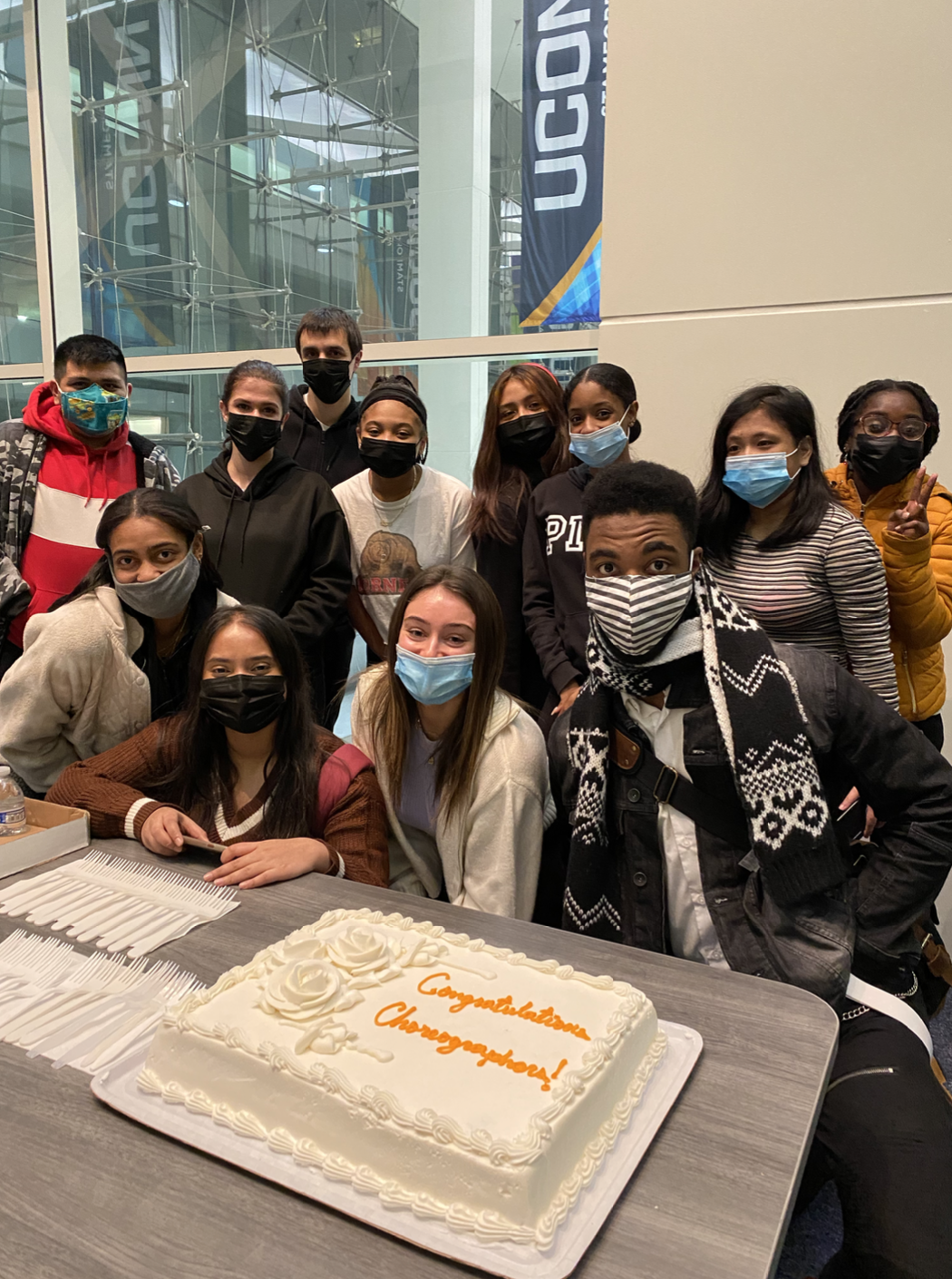
Tracey George and Shawn Lawrence present a Hip-Hop Workshop.
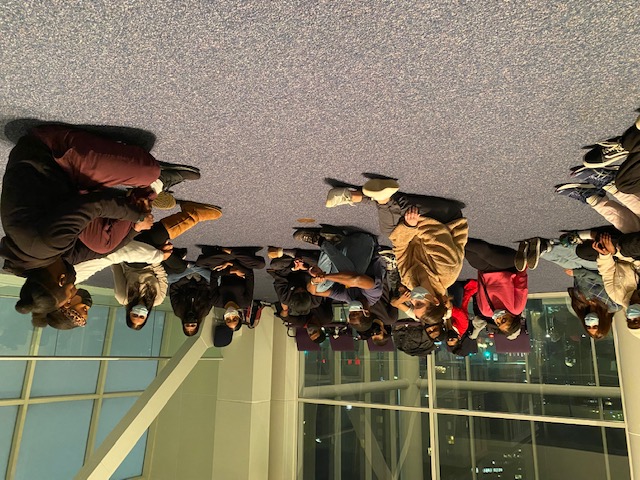
Fall 2020 (Online due to Covid-19)
Working on choreography studies.
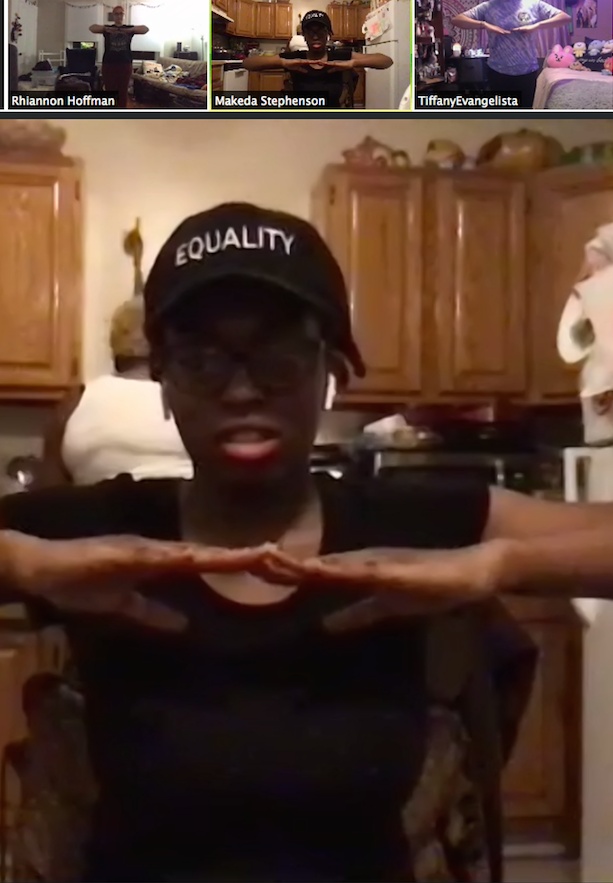
Nicole Anziani teaches an online Latin dance class.
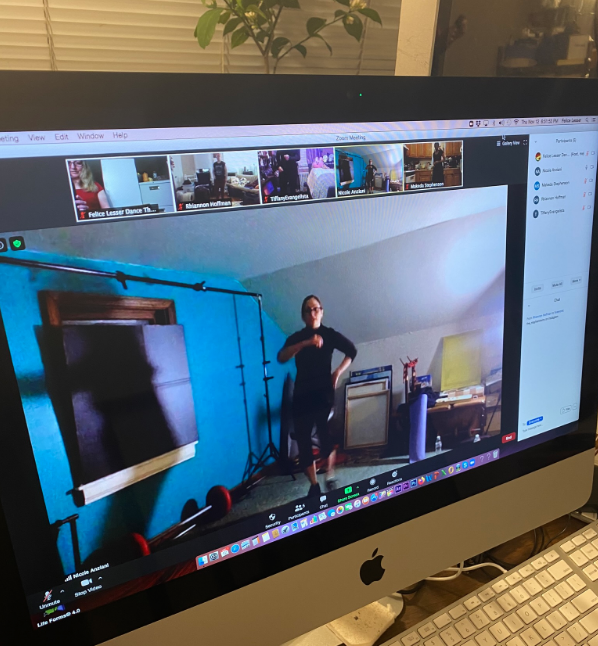
Tracey George teaches an online Hip-Hop class.

Fall 2019
Working on choreography studies.

Tracey George teaches a Hip Hop class.
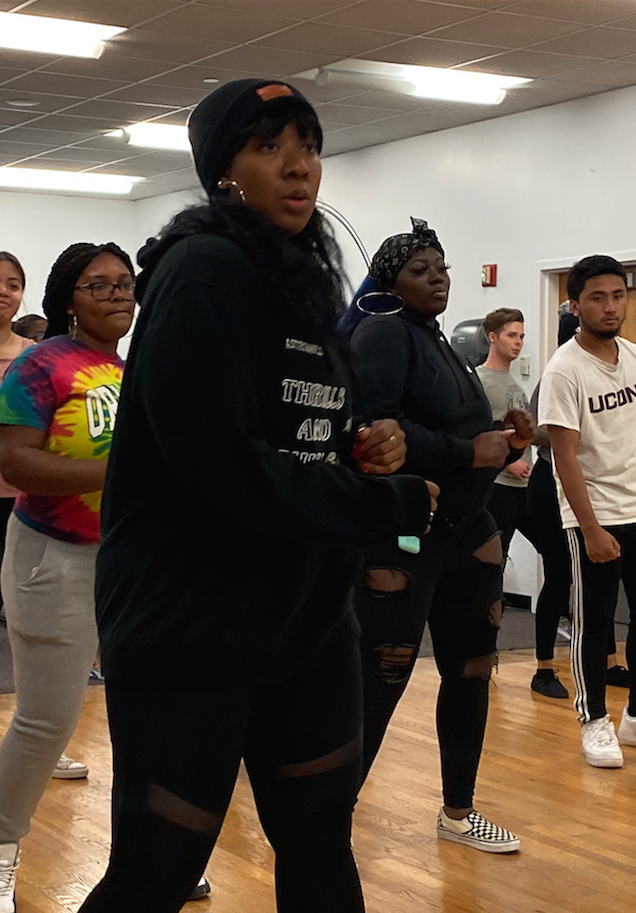
Fall 2018
Student choreographers at their Final Movement Project presentation.
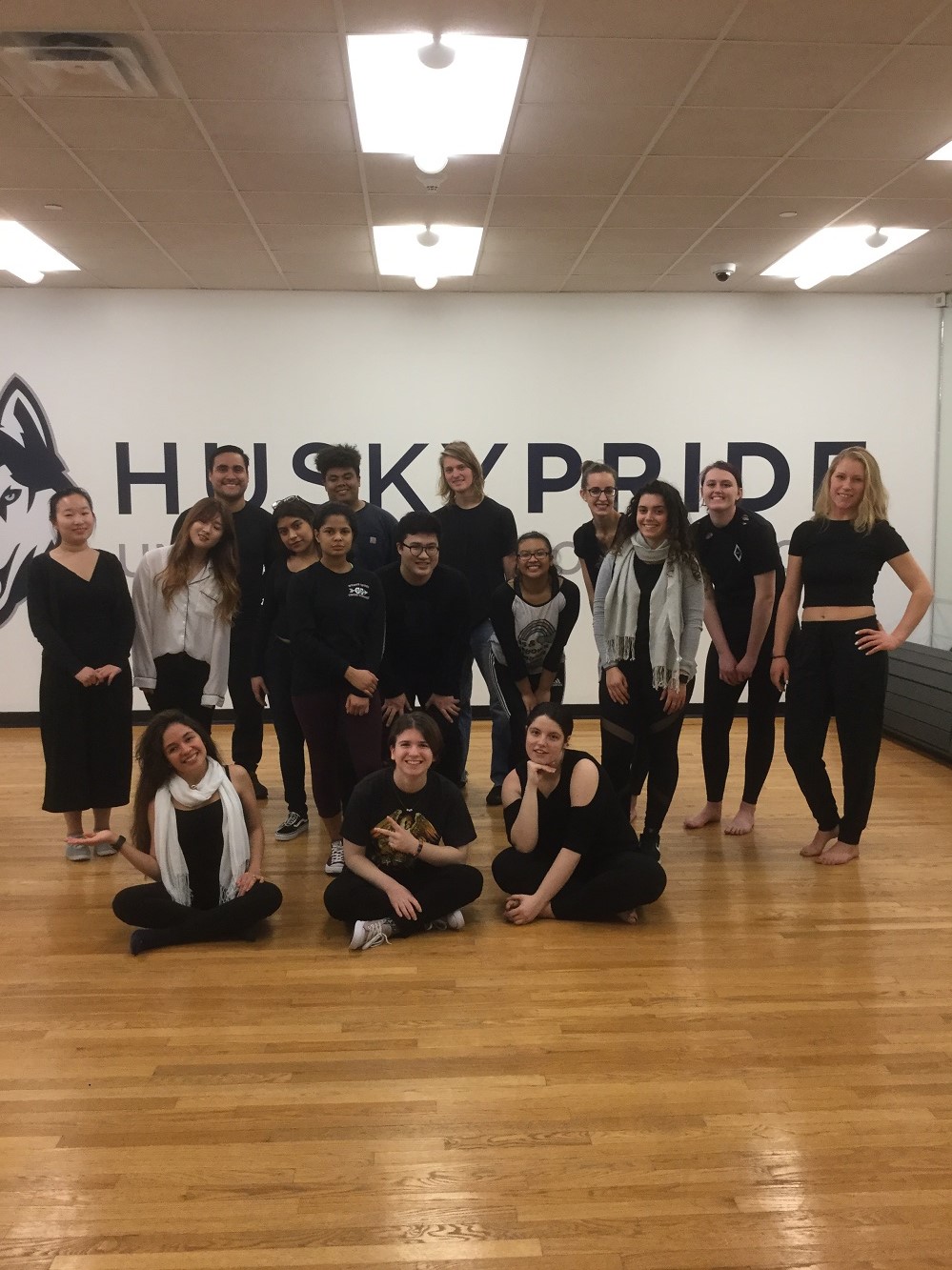
Nicole Anziani teaches a Latin dance class.
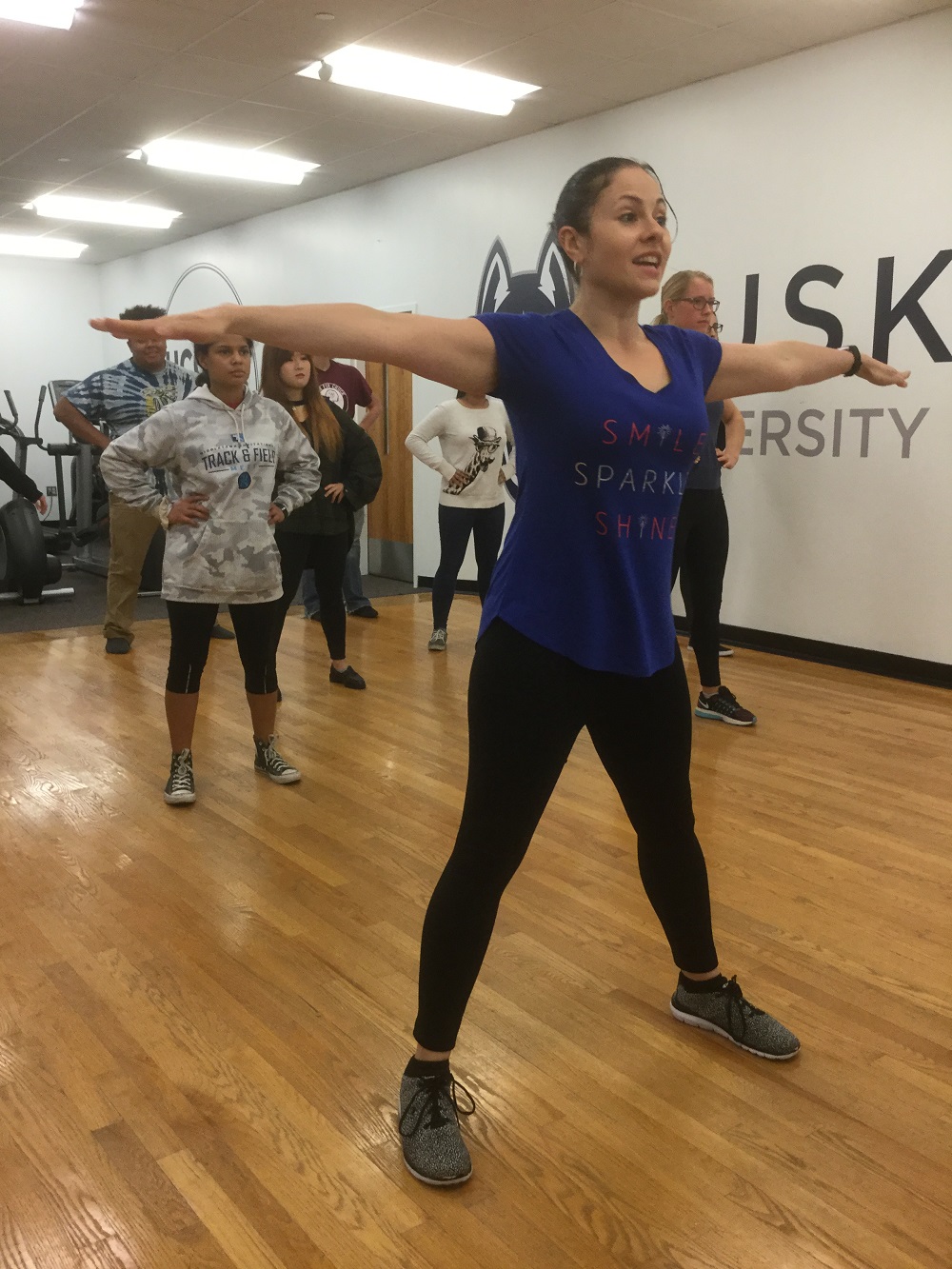
Fall 2017
Students celebrate after presenting their final choreography projects.

FLDT Company Member, Katherine Files, speaks to the class about the lives of today's dancers.

Some of the UCONN/Stamford hallways are lined with metal bars, just perfect for our ballet "barre."
Fall 2016
Students in their final rehearsals for their choreography project presentation.

Fall 2015
Our first dance composition class.
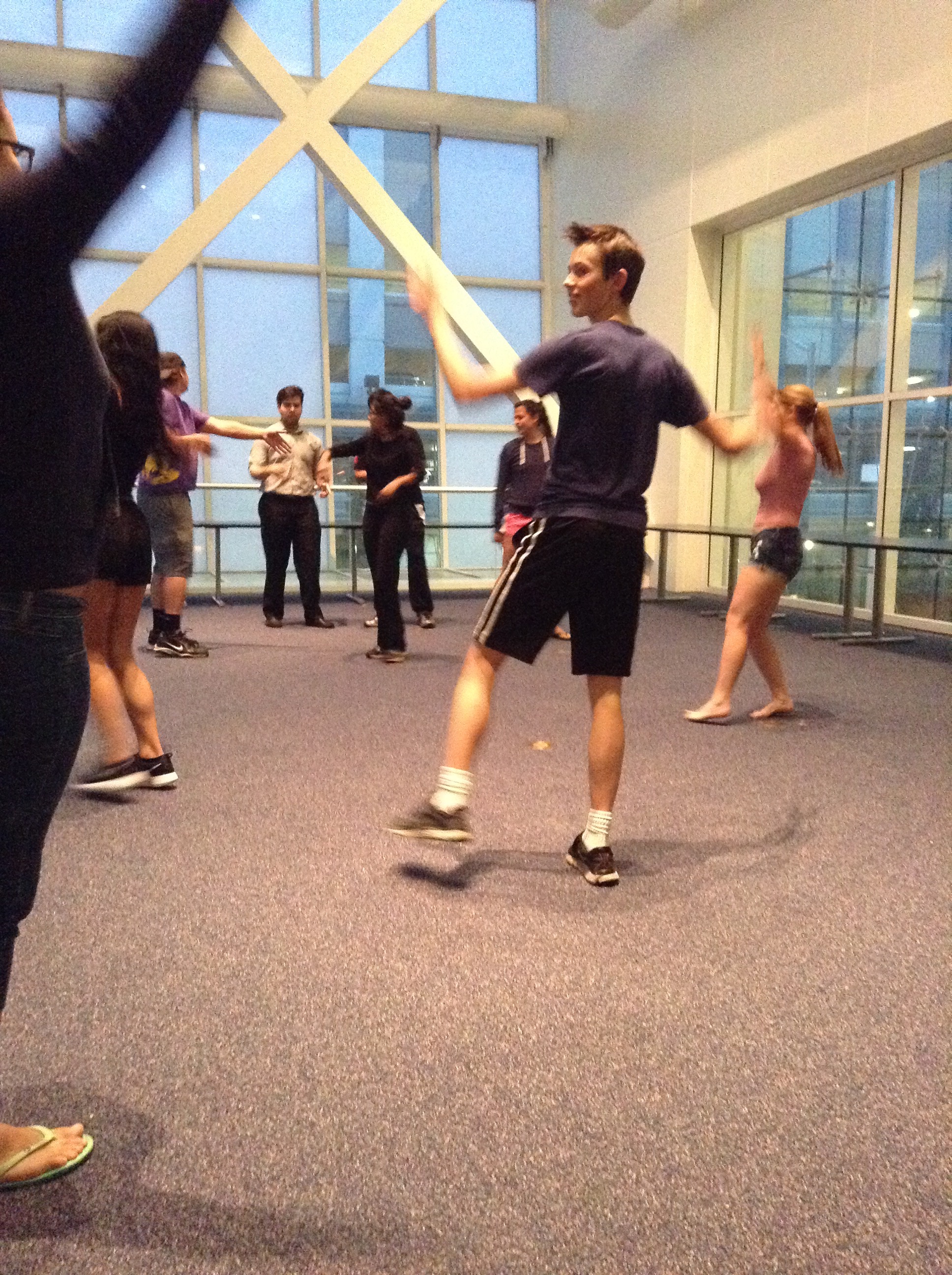
FLDT's Kristin Licata teaches a Horton technique class.
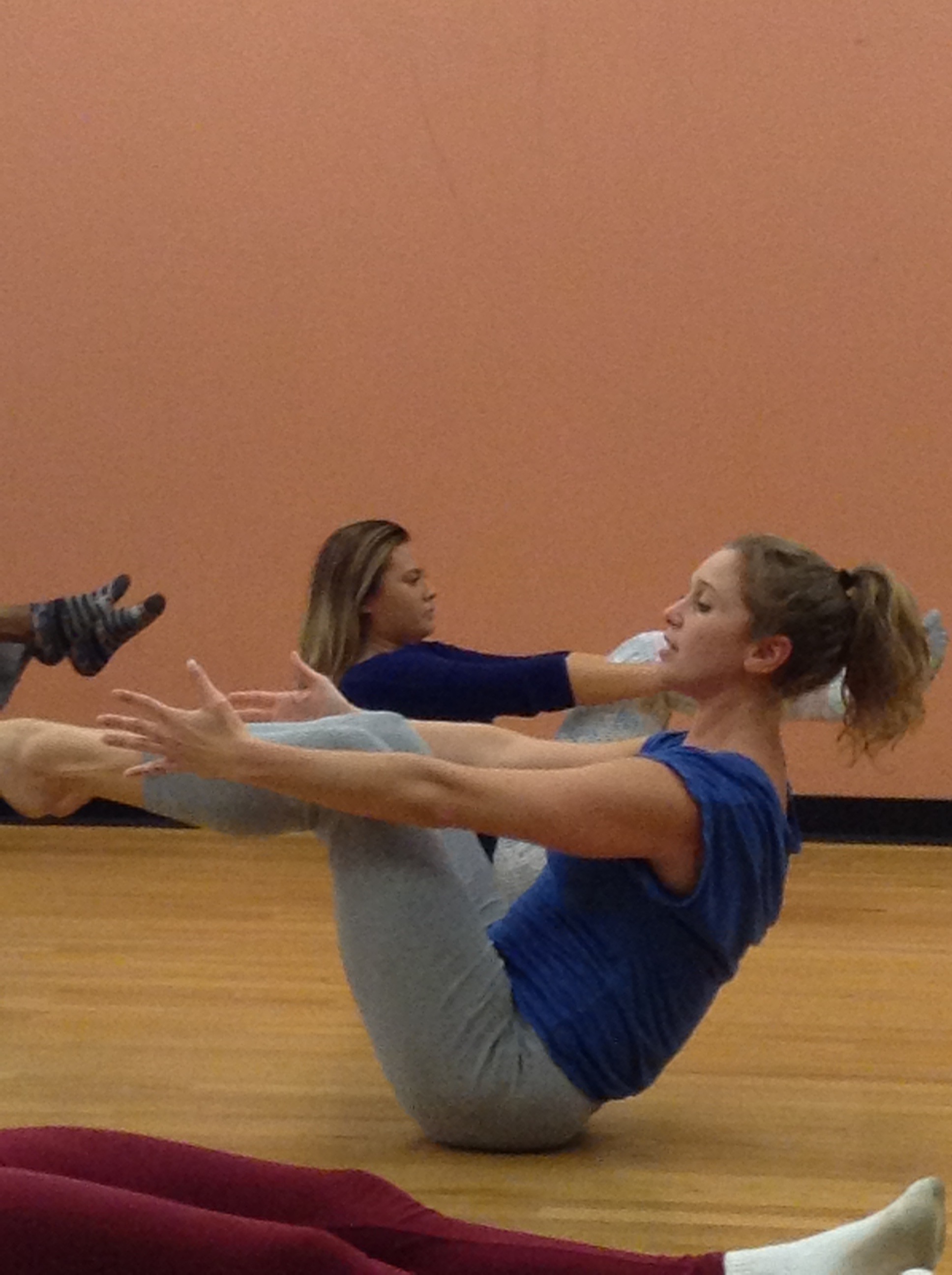
Members of the class celebrate following the presentation of their movement projects.
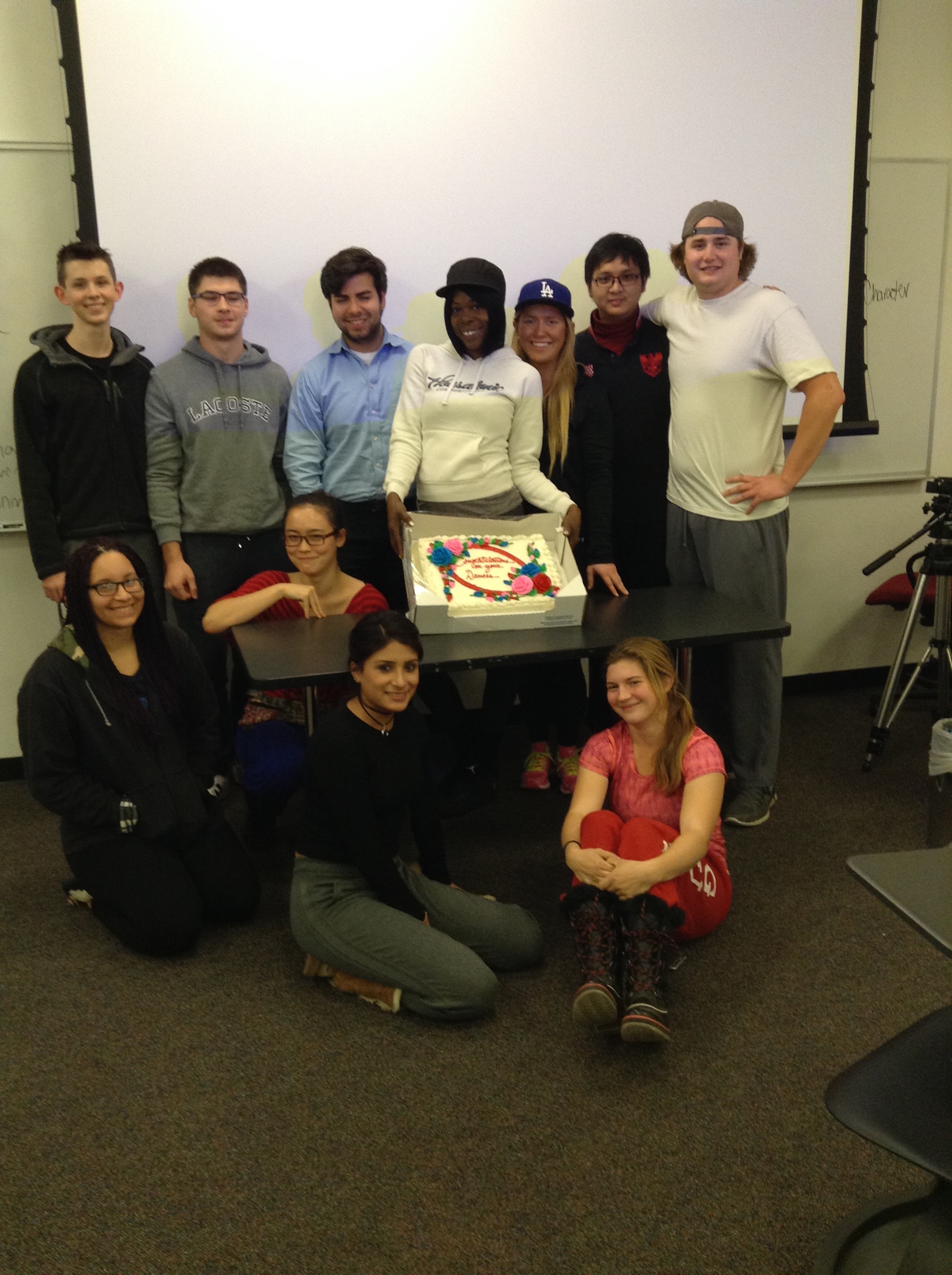
Fall 2014
Students work on improvisation exercises with guest artist, FLDT member, Kristin Licata.
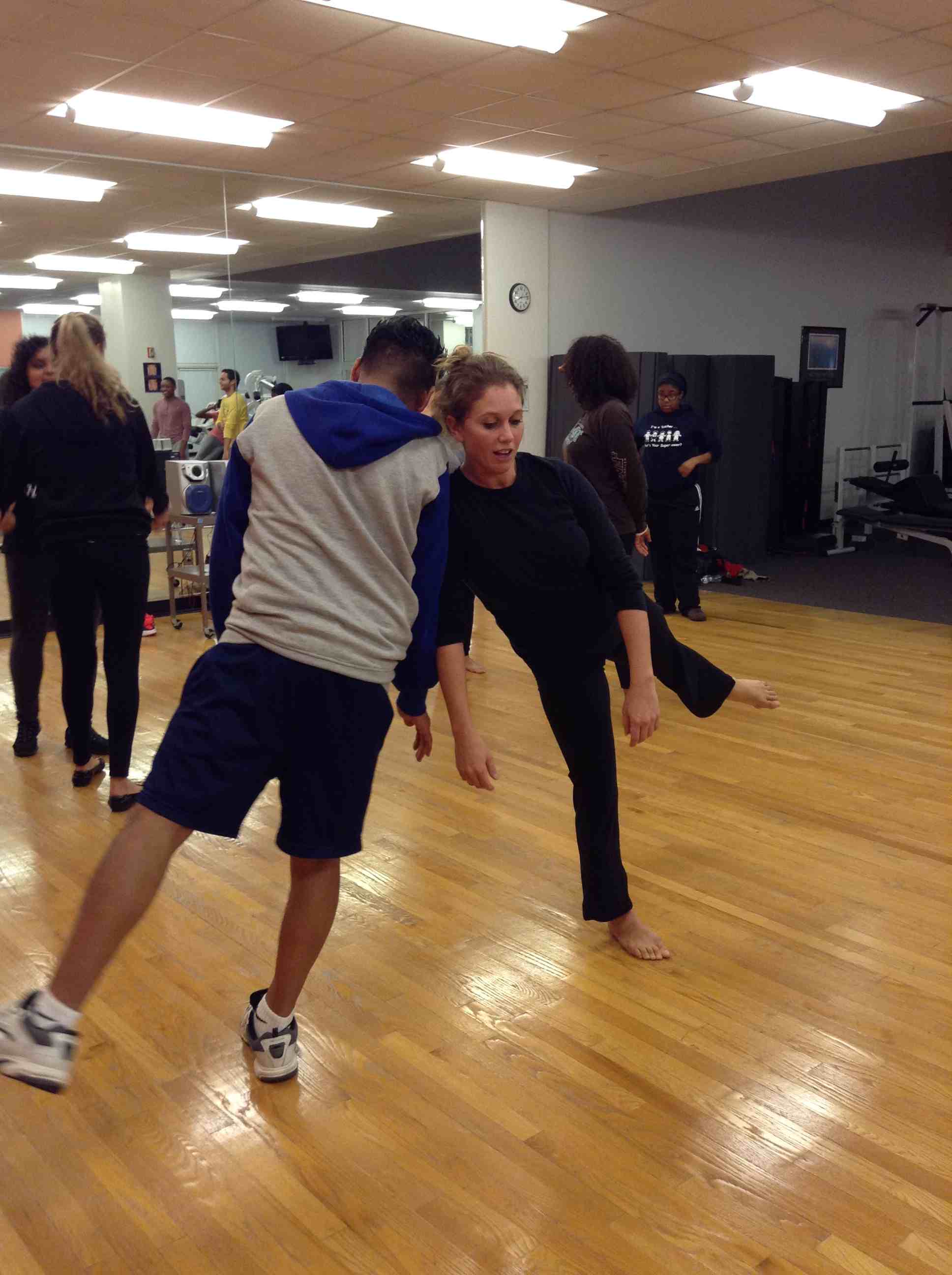
Spring 2014
Students work on Choreography Projects.
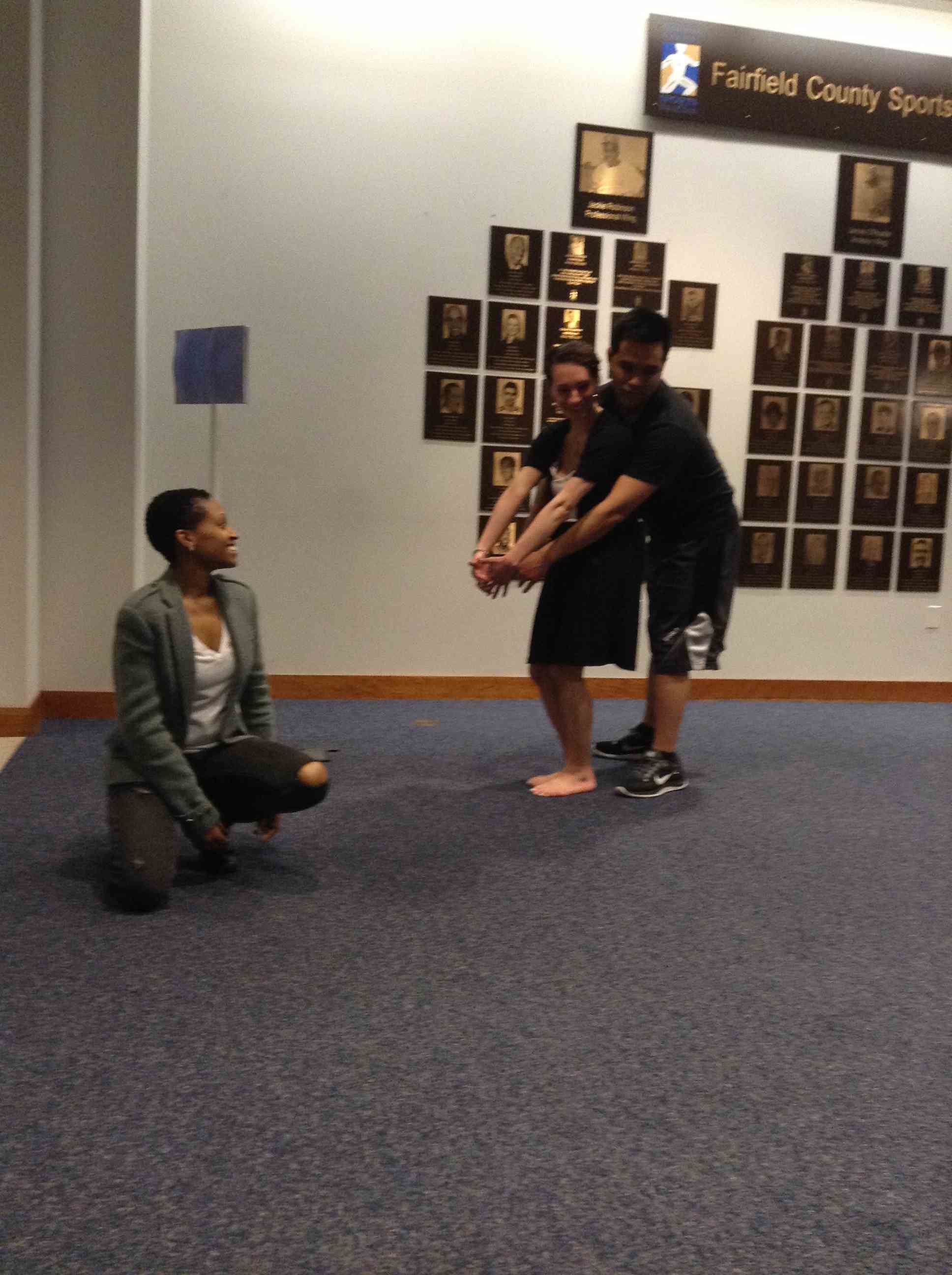
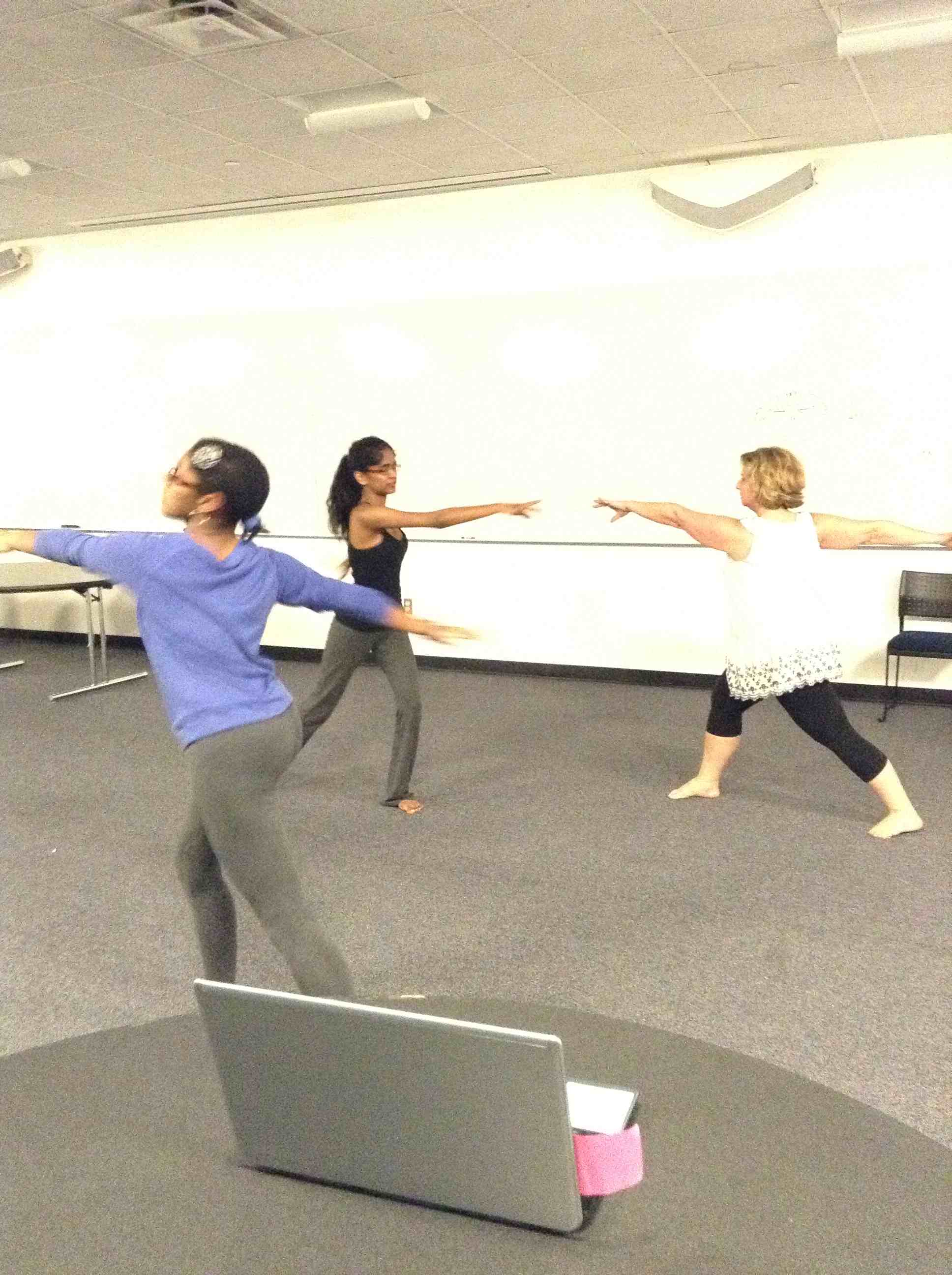
Guest Artists Cheryl Halliburton and John Ward (drummer) teach an African Dance Class.
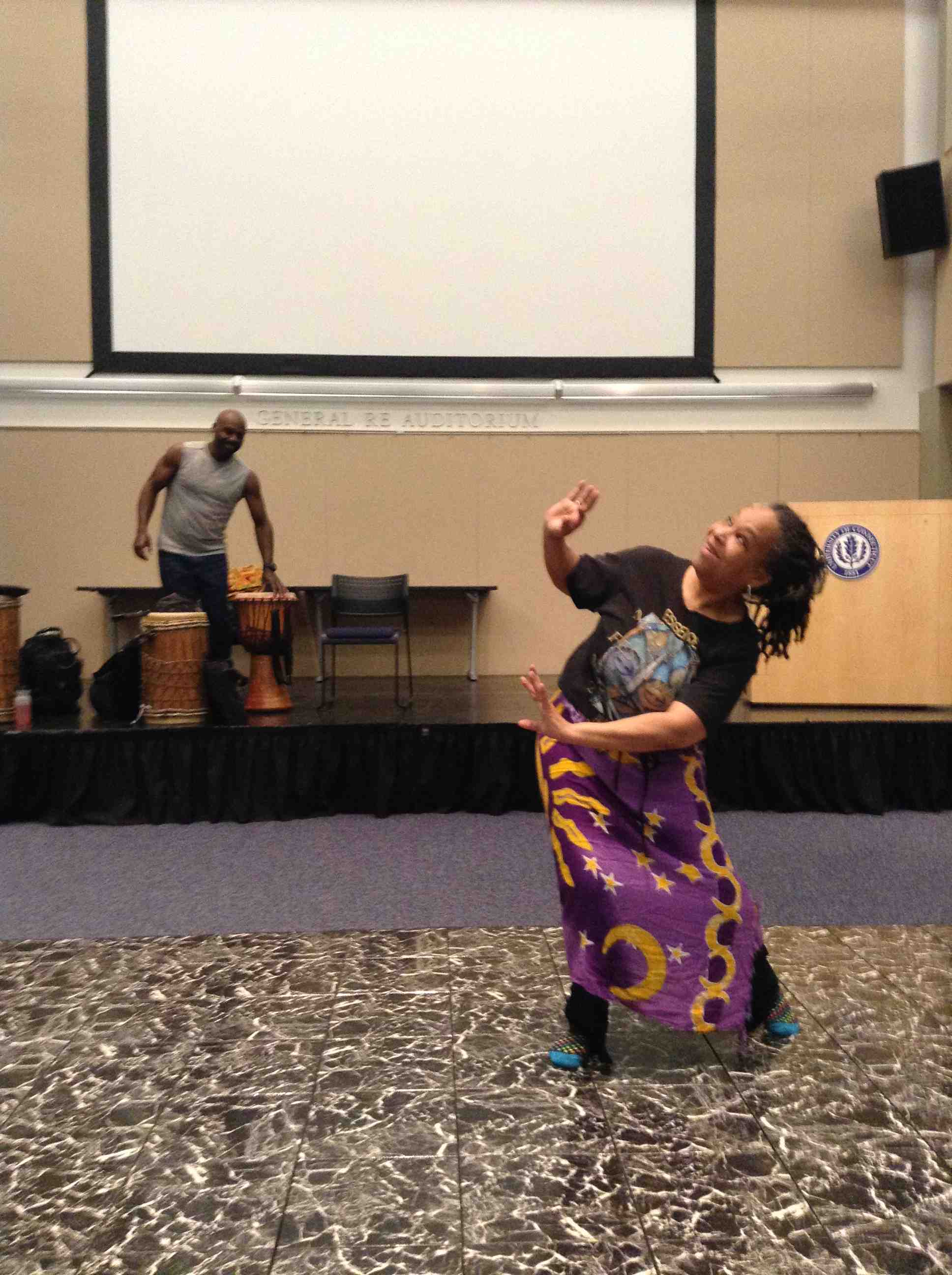
Dancers Lloyd Knight and Kristin Licata travel to UCONN for a session on the lives of professional dancers.
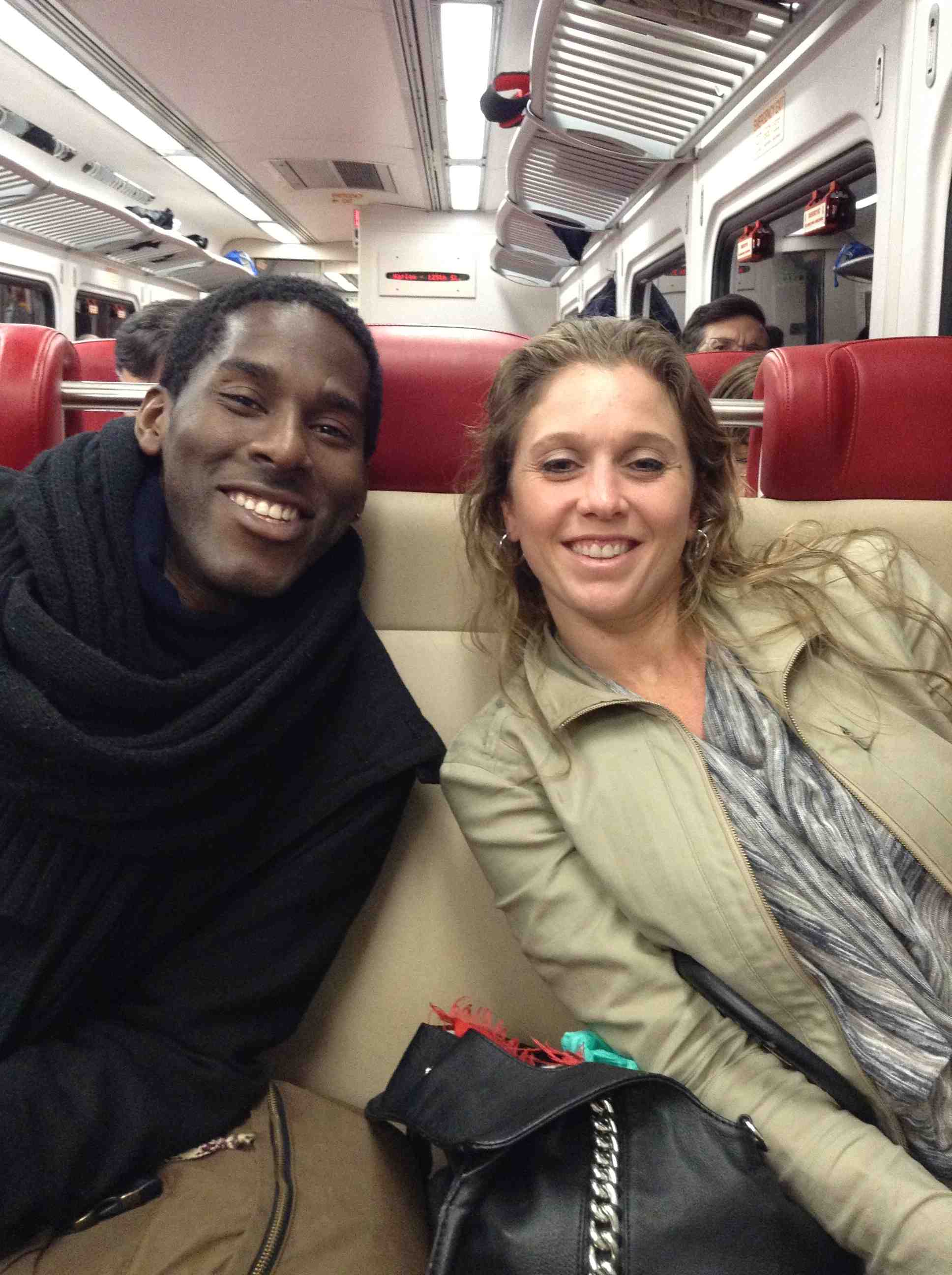
2008
Students in Felice Lesser's "Dance Appreciation" Course at UCONN/Stamford Campus work on an experimental dance video.
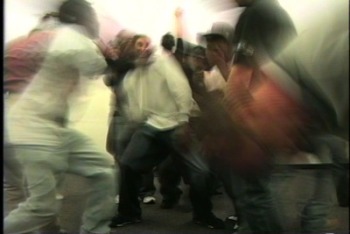
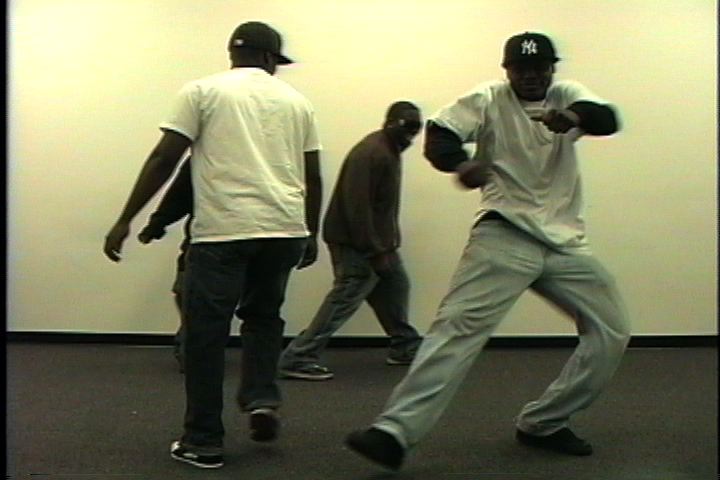
LIFETIME LEARNERS INSTITUTE at Norwalk Community College
2021 (ONLINE, DUE TO COVID-19)
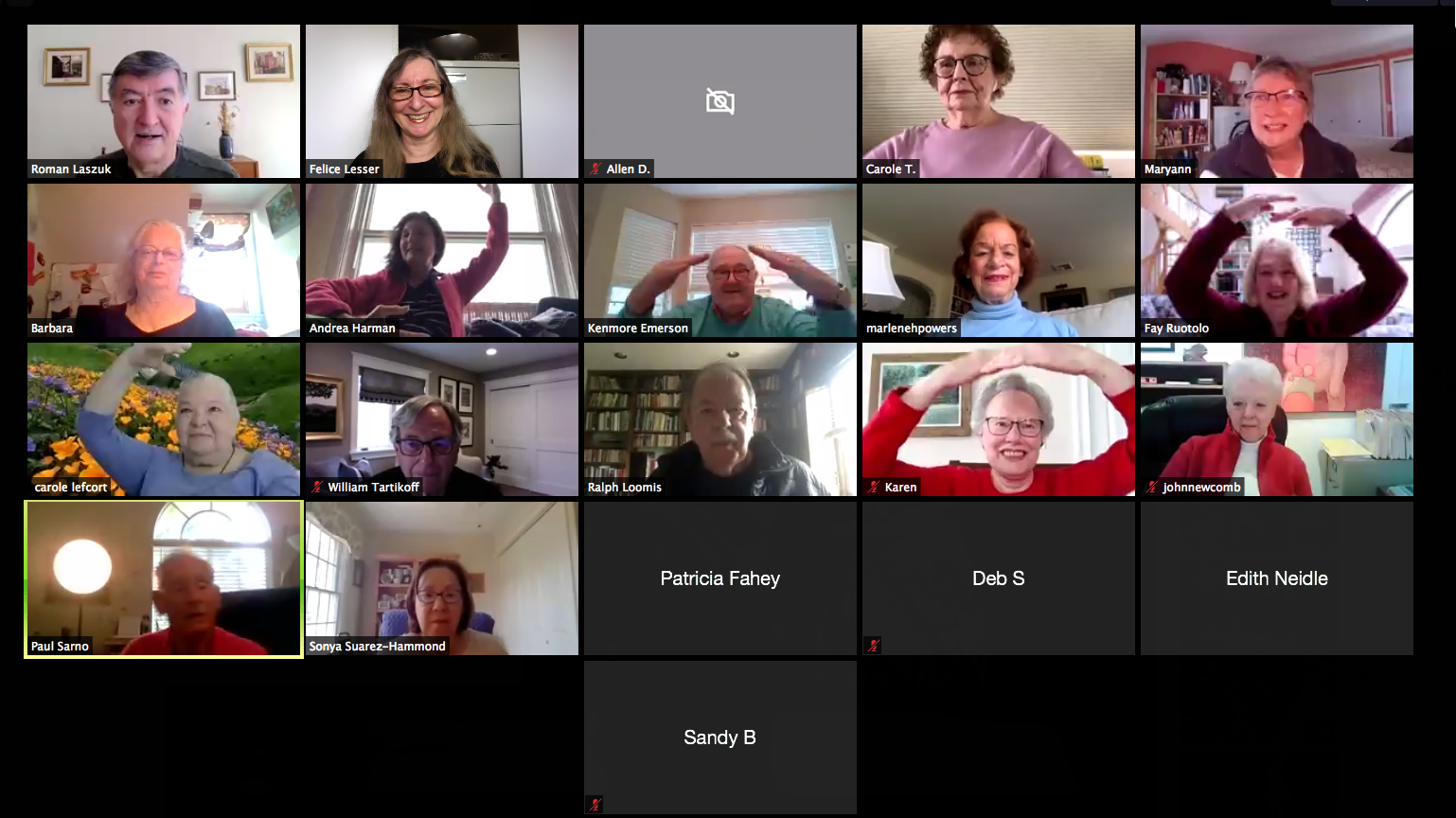
Lifetime Learners Institute at Norwalk Community College is a non-profit organization that reaches adults over age 50, interested in lifelong learning. After an introductory online lecture in 2020, we offered a seven-week online Dance History course there during the 2021 Spring Semester.
ARTS IN EDUCATION PROGRAMS (States of Idaho & Nevada)
Felice Lesser is on the Artist Rosters for the States of Idaho and Nevada, and she presents residencies in schools there. These residencies feature our programs "Dancing on the Keyboard," "Dance Sampler," "Performance Project for Students," & "Dance Around the World." In conjunction with these residencies various outreach events are scheduled such as our popular folk dance evenings (seen in photos below), which bring parents and members of the community into our work. (Dalton Elementary School, Coeur d'Alene, ID)
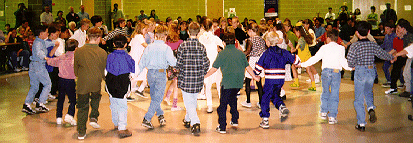

NORWALK COMMUNITY COLLEGE, Norwalk, Connecticut
"The Creative Voice" is a course at Norwalk Community College that deals with various art forms (music, literature, fine art, film, theater, and dance) seen from the creator's perspective. Felice Lesser has been invited to NCC for many years to teach classes on dance and choreography for Professors Carol Solon, Janie Burkhardt and Hannah Moeckel-Rieke's sections of the course. Below students work on dance composition exercises in Dr. Solon's class (11/10/09), Prof. Burkhardt's class (02/25/10, 03/05/12) and Prof. Moeckel-Rieke's class (10/19/11, 10/25/12, 10/28/13, 10/23/17, 10/30/19).
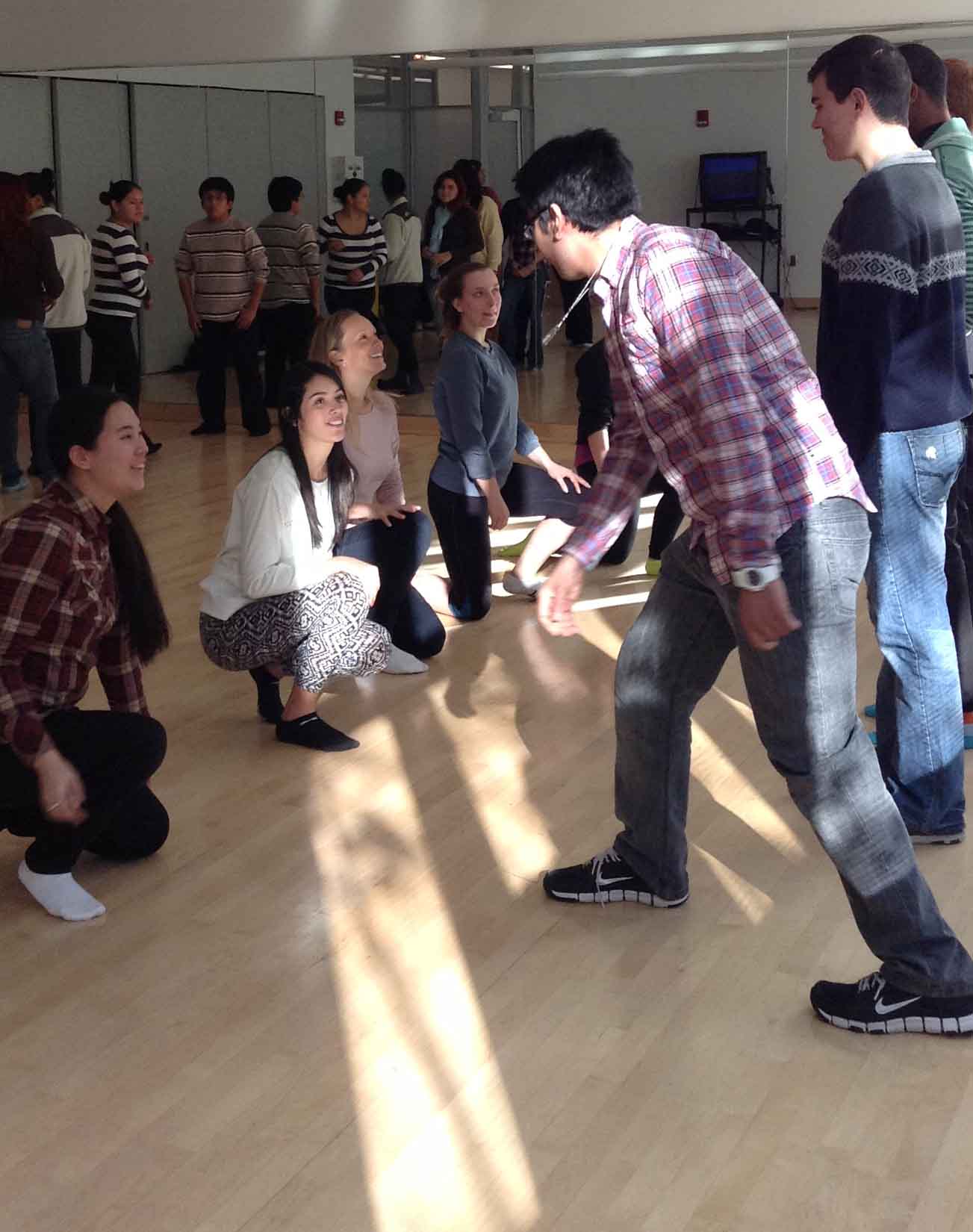
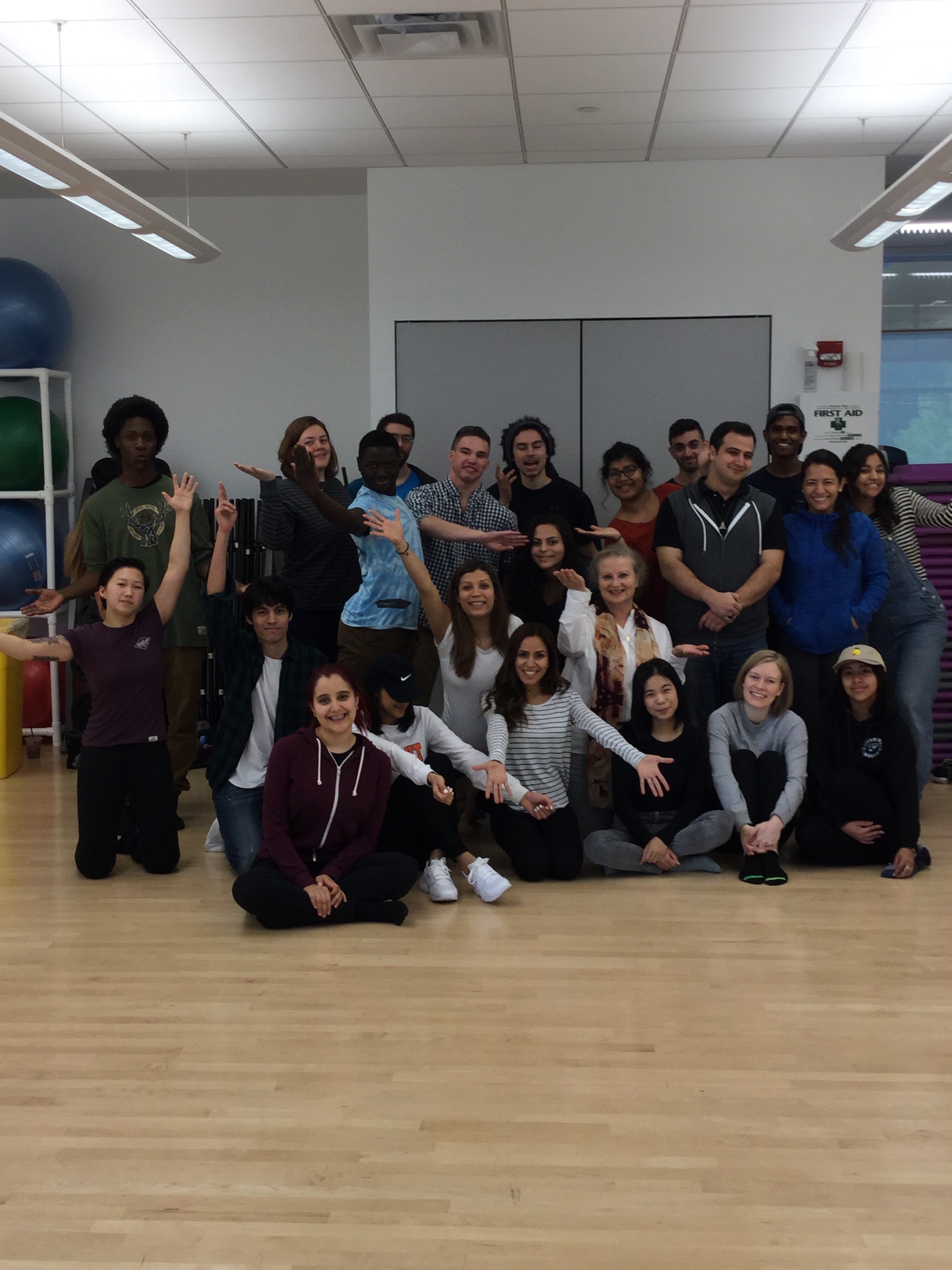
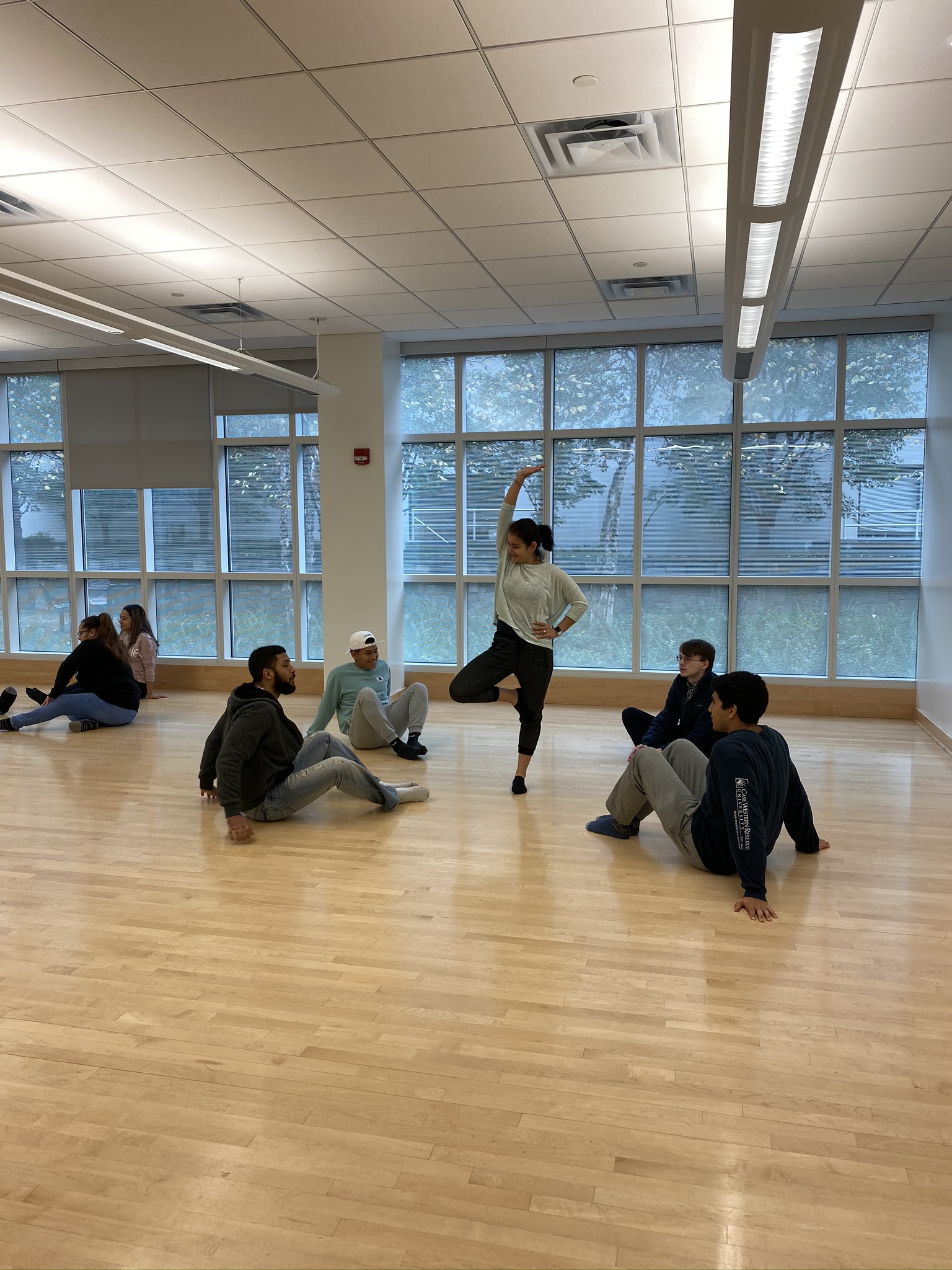
UCONN/Stamford's UPALS PROGRAM
UPALS was a program for local Connecticut teenagers, who were the first in their families to attend college. The program, designed by Dr. Michael Ego, ran for eight years, and FLDT was a part of it since its beginning. UPALS gave Junior and Senior High School students the opportunity to attend special classes at UCONN for a few weeks each summer, studying with the professors there. Students returned year after year, until they graduated from High School. Felice Lesser taught her "Dance Sampler" program there since 2007, presenting students with an introduction to different dance techniques (ballet, modern dance, jazz, tap, folk dance).
In 2012 she was invited to expand the program for an additional week to allow students who had been in UPALS previously to study dance with her again. This extra week focused on choreography. Returning dance students were offered an opportunity to study Dance Composition -- first learning the fundamentals, then choreographing their own dance studies, and finally collaborating on a narrative work (with their choice of plot), jointly choreographed by all the members of the class.
It was an interesting experiment in cooperation, as students drew lots for roles as dancers, then shared the design and shaping of the piece as choreographers. But Lesser found the best part to be a critical lesson in problem solving. "Students saw first-hand, on the very last day, how choreographers cope and deal with seemingly insurmountable obstacles -- when two members of the cast were suddenly out sick, and the others were forced to quickly restructure the entire dance without sacrificing quality, an hour before their performance started. That was a crucial and valuable lesson I think I'll intentionally build into the program next year. Teaching this class I realized, yet again, how important it is for students to study dance (and the arts in general) in school, for the lessons learned (adapting here to change and unexpected circumstances, to cite just one example) are essential to living life. The creativity needed to look for other ways if a first attempt fails, or to roll with the punches, or to take notice of serendipitous accidents (remember Balanchine with the dancer who fell in Serenade?), will also help students deal with whatever comes up in other careers (i.e. medical breakthroughs, new inventions...). So help us get dance and art back into our schools where it belongs!"
UPALS 2014:
Students take turns as the choreographer in a group dance composition project.
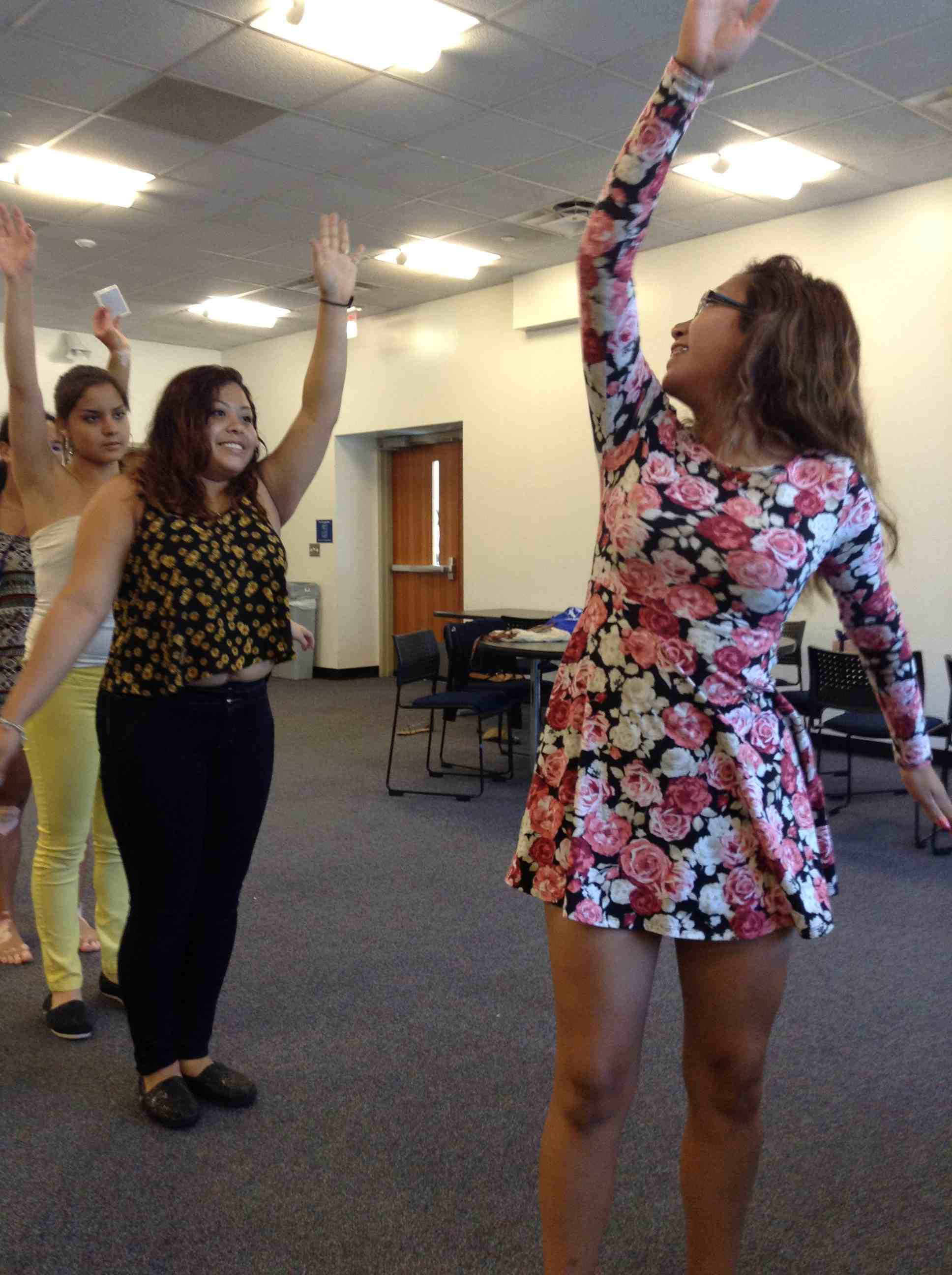
UPALS 2013:
Students learn folk dances to begin the week. This allows them to see how basic human movements (walks, runs, jumps, etc.) become the foundation for dance.

Students stand in first position at the barre in their first ballet class.
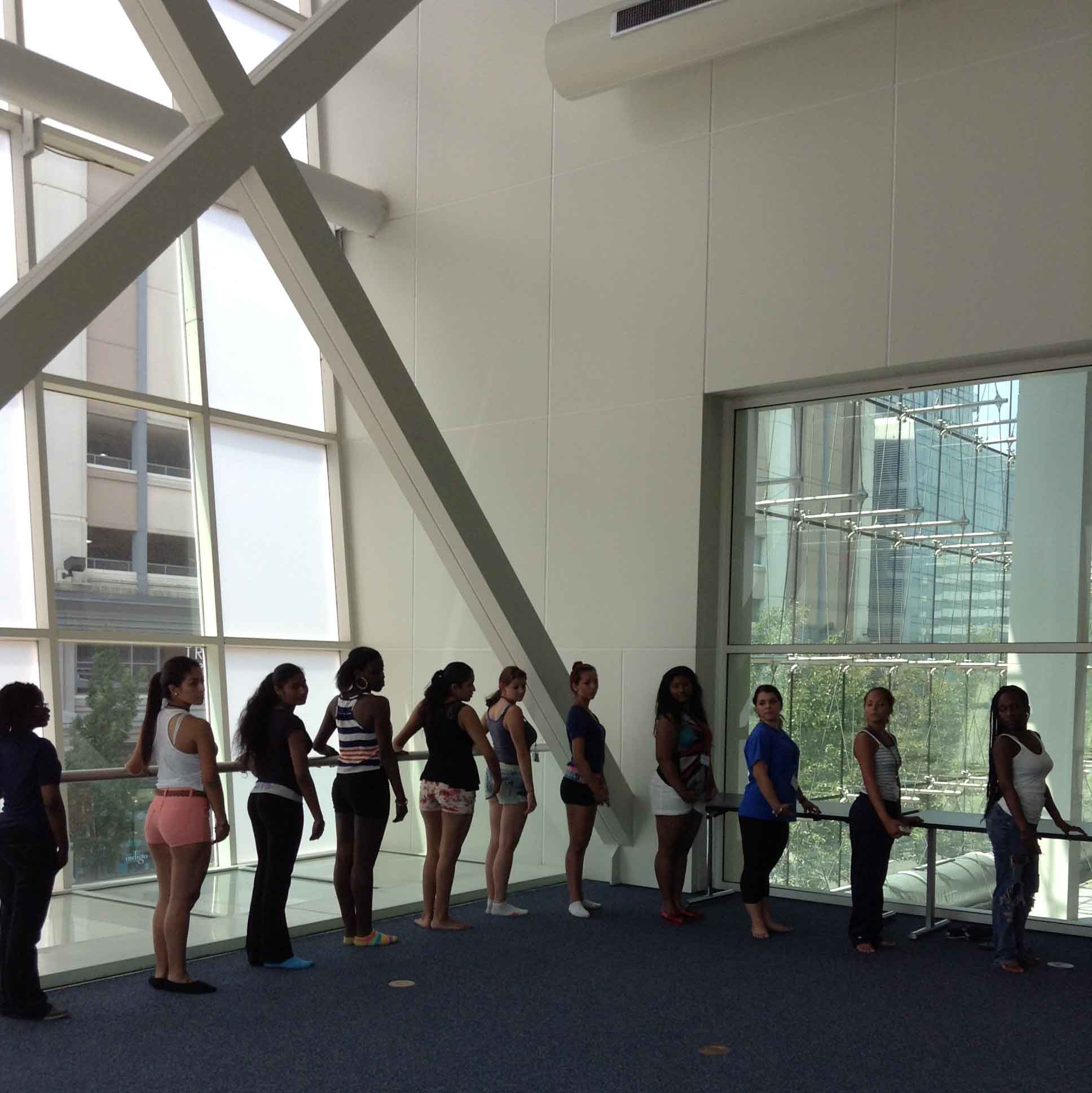
Students study asymmetrical movements in a choreography class.
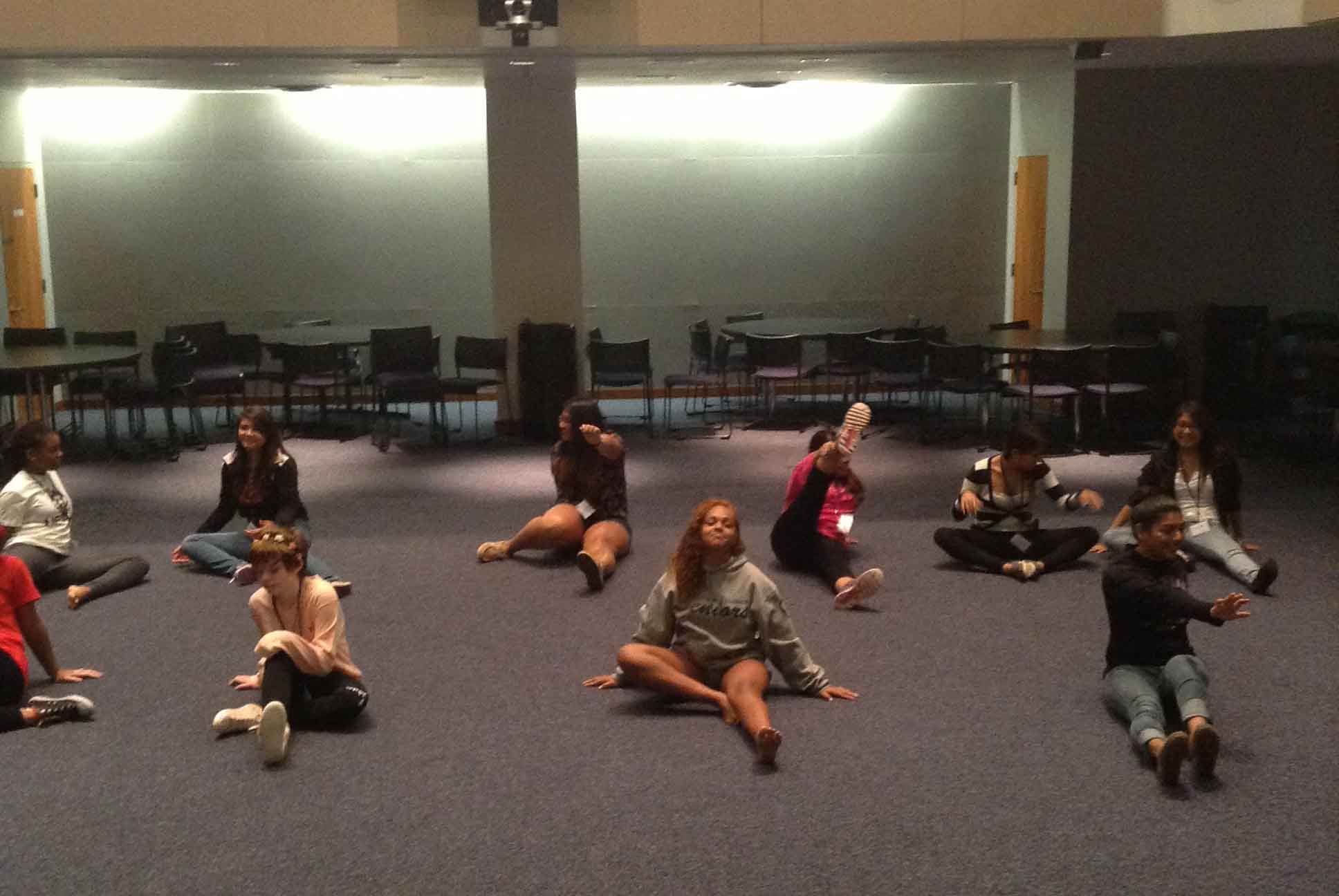
UPALS 2012:
WEEK ONE: Dance Sampler
This year we discovered that some of UCONN's hallways were lined with metal support barres. (And they happened to be just the right height for our ballet classes!)
Modern dance class in the auditorium, where we were also able to watch dance films.
WEEK TWO: Dance Composition
Following a warm up and review of dance technique (practicing grand jétés and sautés)...
Students moved on to choreography... where they jointly created a group dance. After studying the basic elements of dance composition, they chose to compose a narrative dance, drawing lots for roles, and collaborating on the choreography.
UPALS 2011:
Felice Lesser (3rd from right) with her dance students
UPALS students in a modern dance class
and working on their dance composition assignments.
UPALS 2010:
Students study different "levels" in a choreography class.
Then they perform their dance composition study at an assembly for the entire UPALS community.
UPALS 2009
Felice Lesser (back row, 2nd from right) with her dance students
UPALS 2007
UPAL Dance Students in a Folk Dance Class
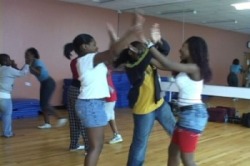
___________________
FLDT Outreach
Our company feels that everyone should have access to the arts, and we offer free classes, programs, workshops and other activities to underserved populations that would benefit from such activities. In the past these have included Seniors, the economically disadvantaged, victims of domestic abuse, runaway and at risk teens & young adults, and people living with AIDS.
Because in the interest of safety, privacy is of the utmost importance to some of our outreach groups, we are only including one photo here -- of our 2000 project with Project FIND (a group for Seniors) in which the participants became an integral part of our onstage work, NEW YORK, NY, via video that was projected behind the live dancers.
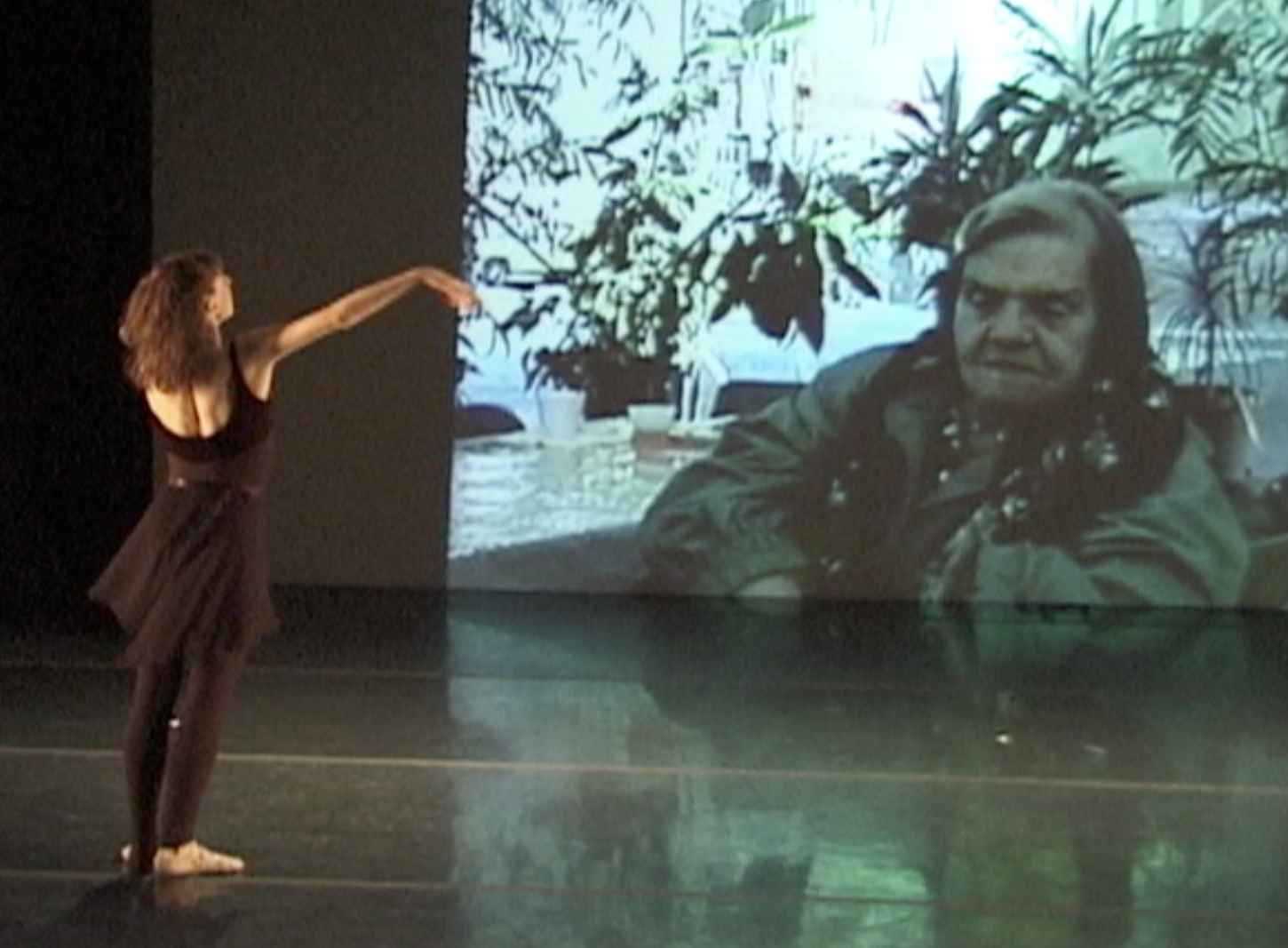
If you are involved with an appropriate organization that could benefit from our free outreach activities, please send us an email through our CONTACT page.
